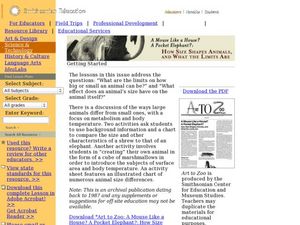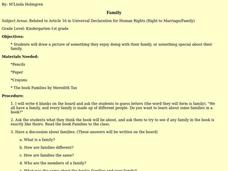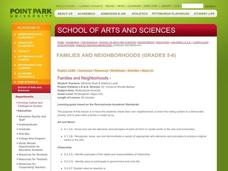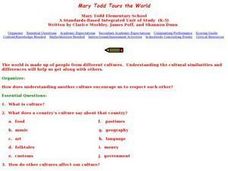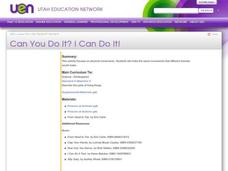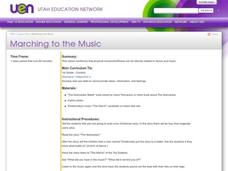Curated OER
Living in the Community
Students explore the differences between the four sectors of business. In this nonprofit business activity, students give examples of needs met by businesses and the importance of the community nonprofit sector.
Curated OER
How Size Shapes Animals
Students investigate how size affects large and small animals differently. In this animal lesson plan, students determine how size affects different animals by constructing their own animal out of marshmallows. Once students create...
Curated OER
Family
Students listen to a teacher read aloud of a book about families before discussing what a family is to them. They discuss how families can be the same or different, who they are made of, and what their traditions might be. They draw a...
Utah LessonPlans
Seed Sort
Students form a variety of categories for seed mixes (wild bird seed or 15 bean soup) and create graphs to display their categories.
Curated OER
Families and Neighborhoods
Pupils build their own neighborhood. In this lesson on community, students are introduced to books about families and neighborhoods. As a class, the pupils create their own neighborhood, elect a leader for their neighborhood and discuss...
Curated OER
Animal Growth Journal
Students observe an animal growth/sponge capsule over time. They record their observations in a journal. They discuss their findings and try to find other animals in different stages of development.
Curated OER
Diversity of Life
Students identify the difference between eukaryote and prokaryotes and examine the structure of bacteria. In this bacteria lesson students examine the different ways that bacteria are classified through an activity.
Curated OER
Can You Do It? I Can Do It!
Students imitate the same movements that different animals would make.
Curated OER
Where You Belong
Learners identify different groups to which they belong, and use counting techniques to take a census of their family and class.
Curated OER
Animal Growth Journal
Students observe and describe animals in the local environment. They recall information about different animals they have seen. They read and discuss their favorite animal books.
National Endowment for the Humanities
The Greek Alphabet: More Familiar Than You Think!
In this Greek alphabet lesson, pupils explore the Phoenician origins to the Greek alphabet. Learners compare Greek letters to current letters and write a paragraph about the life of students in ancient Greece. They also identify Greece...
Curated OER
Mary Todd Tours the World
Pupils analyze how distinguishing another culture encourages us to respect each other. They research culture and all its avenues, recognizing and comprehending the relationship between people and geography. Ultimately, they can apply...
Media Smarts
The Broadcast Project
As part of a unit on media studies, kids are asked to chart their viewing habits, observe the advertising that sponsors their favorite shows, and then to imagine what they would broadcast if given a block of airtime.
Curated OER
Pets - Stuffed Animal Day
Students listen to Courtney Baker's, "The Perfect Pet," on a day they bring a stuffed animal to school. They graph the types of stuffed animals that their classmates brought to school before answering questions based on the graph. Next,...
Curated OER
Can You Do It? I Can Do It!
Students explore animal movements. They listen to the book, 'From Head to Toe,' discuss the animal movements, and imitate the animal actions during a rereading of the story.
Curated OER
Chrysanthemum and Letter Tiles
Students listen as the teacher reads Chrysanthemum. They discuss the story, focusing on the length of Chrysanthemum's name. They compare the lengths of their own names using letter tiles, grid paper, and a class graph.
Curated OER
How Do You Feel Today?
Students create a graph, then listen to Dr. Seuss' book, My Many Colored Days. After the story, they do a similar graph and then compare the two graphs.
Curated OER
Seasons
Students listen to stories about the seasons, and discuss the kinds of clothing people wear for each season. They take a walk, collecting items to go with each season, then draw pictures to match the season.
Curated OER
Seasons
Students explore the four seasons. Through observation activities, they explore and discuss the weather changes that occur during each season. Students create a graph of the clothing that is worn during each season.
Curated OER
Marching to the Music
This instructional activity reinforces that physical movement/fitness can be directly related to dance and music. Tell the pupils that you are going to read a fun Christmas story. In the story there will be toys that magically come...
Utah LessonPlans
Water Magicians
Students observe water changing states from a solid to a liquid to a gas.
Curated OER
Pets: Stuffed Animal Day
Students bring in their favorite stuffed animals to class, and listen to the book, The Perfect Pet. They develop graphs for their stuffed animals, and create booklets titled, My Pet Book.
Curated OER
Recognizing Numerals and Numbers
Students develop number sense as well as number and number symbol awareness. Through various center activities, they practice recognizing the number symbol that is associated in a particular quantity. Instructions for four center...



